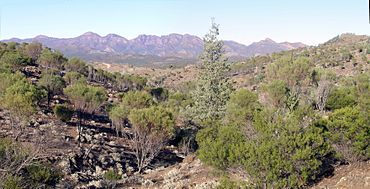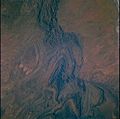Ikara-Flinders Ranges National Park facts for kids
Quick facts for kids Ikara-Flinders Ranges National ParkSouth Australia |
|
|---|---|
|
IUCN Category II (National Park)
|
|

Ikara-Flinders Ranges National Park
|
|
| Nearest town or city | Hawker |
| Established | 1 January 1945 |
| Area | 933.97 km2 (360.6 sq mi) |
| Managing authorities | Department for Environment and Water |
| Website | Ikara-Flinders Ranges National Park |
| See also | Protected areas of South Australia |
The Ikara-Flinders Ranges National Park is a huge natural park in South Australia. It's about 400 km north of Adelaide. The park is part of the Flinders Ranges, which is the biggest mountain range in South Australia. It covers a large area of 912 km². The park is located northeast of the small town of Hawker. Two famous walking and cycling paths, the Heysen Trail and Mawson Trail, go through the park.
The most famous part of the park is Wilpena Pound. This is a giant, natural bowl-shaped area that looks like a sickle. It covers almost 80 km². Inside Wilpena Pound is St Mary Peak, which is the highest point in the range at 1,170 metres tall. On February 12, 2016, the park's name was changed. The word Ikara was added, which is an Adnyamathanha word meaning "meeting place." This refers to the traditional name for Wilpena Pound.
You can reach the main park centre at Wilpena Pound by a sealed road from Hawker. Other parts of the park have unsealed roads. Most cars can use these roads, but it's best to use a four-wheel drive if the weather is bad or after heavy rain. The park has many amazing places to see. These include lookouts, beautiful views, small canyons, and unique rock shapes. Some popular spots are Wilkawillina Gorge, Hucks Lookout, Brachina Gorge, Bunyeroo Gorge, and Arkaroo Rock. You can also find old stone ruins from early European settlers. There are also Aboriginal rock art sites. A cool rock formation called the Great Wall of China is just outside the park. You can go camping in many areas throughout the park.
Contents
Exploring the Park's Geology
The Flinders Ranges are mostly made of old rocks that have been folded and broken. These rocks were laid down in a huge basin a very long time ago. This was during a period called the Neoproterozoic era. The rocks formed on the edge of an ancient continent named Rodinia.
About 540 million years ago, during the Cambrian period, the area changed a lot. The rocks were pushed and folded to create a large mountain range. This event is called the Delamerian orogeny. Since then, wind and water have slowly worn down the mountains. This is why they are not as tall today.
Most of the high parts and ridges in the Flinders Ranges are made of a hard rock called quartzite. The tall walls of Wilpena Pound are made from this same rock, which forms a giant bowl shape. This quartzite also makes up other high areas, like the Gammon Ranges and the Heysen Range. You can also see many cuesta forms, which are hills with a gentle slope on one side and a steep cliff on the other.
Plants and Animals of the Park
The plants in the Flinders Ranges are mostly types that can live in a dry environment. You will see cypress-pine trees, mallee trees, and black oak trees. In wetter spots near Wilpena Pound, you might find grevilleas, Guinea flowers, lilies, and ferns. Near permanent water sources like springs and waterholes, you can see reeds and sedges growing.
Amazing Animals of the Flinders Ranges
After dingos were removed and permanent waterholes were made, the number of some animals grew. You can now see more red kangaroos, western grey kangaroos, and euros. The yellow-footed rock-wallaby almost disappeared when Europeans arrived. This was due to hunting and attacks by foxes. But now, their numbers are stable. Other small marsupials you might spot include dunnarts and planigales. The echidna is the only monotreme (a mammal that lays eggs) in the park. Many types of insect-eating bats also live here.
Reptiles and Amphibians
The park is home to many reptiles. These include goannas, snakes, dragon lizards, skinks, and geckos. The streambank froglet is a special type of frog found only in this area.
Birds of the Park
There are many different kinds of birds in the park. You can see various parrots, emus, and large wedge-tailed eagles. There are also a few waterbirds. The park is known as an Important Bird Area (IBA) by BirdLife International. This is because it has a healthy population of the short-tailed grasswren, a bird that lives only in certain areas.
Historical Sites in the Park
The Ikara-Flinders Ranges National Park has several places that are important for their history. These sites are protected because they tell us about the past. They include old homesteads, ruins, and special geological spots. Some of these heritage-listed sites are:
- Eddie Pumpa Outstation
- Hayward Homestead Ruins
- Wilpena Homestead Complex
- Wills Homestead Complex Ruins
- Appealinna Mine Ruins and Miners Hut
- Dingley Dell Homestead Ruins
- Hill's Cottage, Wilpena Pound
- Oraparinna Station Blacksmith's Shop
Images for kids
See also
 In Spanish: Parque nacional Montes Flinders para niños
In Spanish: Parque nacional Montes Flinders para niños



